|
Have a safe day!
Thursday, Jan. 5
10 a.m.
Particle Astrophysics Seminar - One West
Speaker: Brian Nord, University of Michigan
Title: Can We Realize the Potential of Galaxy Cluster Surveys with Multi-Wavelength Analyses?
1 p.m.
Special Seminar - One West
Speaker: Paul Alivisatos, Lawrence Berkeley National Laboratory
Title: Scientific Case for a Next Generation Light Source: A Transformative
Tool for X-Ray Science
THERE WILL BE NO THEORETICAL PHYSICS SEMINAR THIS WEEK
3:30 p.m.
DIRECTOR'S COFFEE BREAK - 2nd Flr X-Over
THERE WILL BE NO ACCELERATOR PHYSICS AND TECHNOLOGY
SEMINAR TODAY
Friday, Jan. 6
11 a.m.
Special Seminar - Curia II
Speakers: Andrew Brandt, University of Texas, Arlington; Christopher Scholz and Dan Steinken, LeCroy Corporation
Title: Timing R&D for a 10 ps Time-of-Flight Detector Featuring LeCroy’s LabMaster 9Zi Oscilloscope
3:30 p.m.
DIRECTOR'S COFFEE BREAK - 2nd Flr X-Over
THERE WILL BE NO JOINT EXPERIMENTAL-THEORETICAL PHYSICS SEMINAR THIS WEEK.
Click here for NALCAL,
a weekly calendar with links to additional information.
Upcoming conferences |
|
Thursday, Jan. 5
- Breakfast: Apple sticks
- Tomato florentine
- BBQ pork sandwich
- Smart cuisine: Kielbasa & sauerkraut
- Smart cuisine: Chicken marsala
- Smoked turkey melt
- Assorted sliced pizza
- Southwestern chicken salad w/ roasted corn salsa
Wilson Hall Cafe Menu
|
|
Wednesday, Jan. 11
Lunch
- Northern Italian lasagna
- Caesar salad
- Spumoni ice cream
Friday, Jan. 13
Dinner
- Coquille St. Jacques
- Pork tenderloin w/ marsala sauce
- Steamed broccoli
- Roasted potatoes w/ onions
- Apple turnover w/ cream chantilly
Chez Leon Menu
Call x3524 to make your reservation. |
|
Paul Alivisatos lecture - today
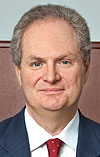 |
Paul Alivisatos
Photo courtesy of LBNL, Roy Kaltschmidt
|
Paul Alivisatos, the director of Lawrence Berkeley National Laboratory, will present a lecture from 1 to 2 p.m. today in One West. The lecture is titled, "Scientific Case for a Next Generation Light Source: A Transformative Tool for X-ray Science."
|
First successful test run for
J-PARC after earthquake
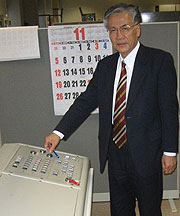 |
|
In 2006, J-PARC director Shoji Nagamiya turned the key to start accelerating beam at the Linac. After March's earthquake, the complex has made repairs to continue accelerating beam. Photo courtesy of J-PARC director Shoji Nagamiya
|
Editor’s note: For over 30 years, Japanese and American researchers have enjoyed collaborating under the U.S.-Japan Agreement on High-Energy Physics.
Ten months after the earthquake and tsunami that devastated northern Japan, the Japan Proton Accelerator Research Complex (J-PARC) completed the first full test run for their system.
On March 11, 2011, the complex was extensively damaged, halting experiments for the highly international collaboration. From water in the Linac area to displaced walls and roads, it was clear that a great deal of work was ahead. The J-PARC center team created a master recovery schedule in May of 2011. The team met every milestone on time.
The complex, built as a joint project between the Japan Atomic Energy Agency and the High Energy Accelerator Research Organization (also known as KEK) with heavy international cooperation, houses several diverse research facilities. Three accelerators produce a primary proton beam used in tandem with smaller, more specific beams in each facility, based on use. For example, the T2K research team studies neutrinos produced from the primary proton beam.
The J-PARC team produced the first beam from the Linac on Dec. 9, a huge step signaling their ability to take beams at increasing energies. Just two weeks later, on Dec. 26, a full test run of the beam production and extraction through the neutrino hall was successfully completed.
While there are still a number of repairs to make, and the beam power is not quite at what was achieved prior to the earthquake, the center team expects to open J-PARC to users by the end of January.
In a series of email updates detailing the continued improvements, Shoji Nagamiya, director of J-PARC, expressed his gratitude for the many well-wishes from around the world. As a major component of J-PARC’s mission, the international support was greatly appreciated.
—Ashley WennersHerron
|
Playgroup holiday party
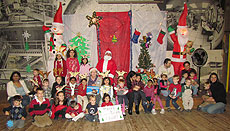 |
|
On Friday, Dec. 16, NALWO's playgroup celebrated the holidays with a visit from Santa Claus. Photo: Gabriella Lima, WDRS
|
|
Survey tunes in to dark energy
From Nature, Jan. 4, 2012
Sonic yardstick offers a measure of Universe's expansion.
David Schlegel's tool for exploring dark energy, one of nature's biggest mysteries, is deceptively simple. It is an aluminium plate the size of a manhole cover — or rather, 2,200 of them, each with a specific pattern of holes drilled to match the arrangement of galaxies in a particular section of the sky. Every plate is used once, for an hour, at the prime focus of the 2.5-metre telescope at Apache Point Observatory in New Mexico. When the telescope is pointing at the correct spot, light from each galaxy streams through its corresponding hole. The light is then broken up into its constituent wavelengths and used to clock how fast each galaxy is being carried away from us by the relentless expansion of space.
The study, which began in 2009, will ultimately gather data from 1.5 million galaxies. Its goal is to measure dark energy — a phenomenon thought to be driving the Universe to expand at an ever-increasing rate — and discern whether its influence has remained constant or has varied slightly across billions of years of cosmic history.
Read more
|
Neutrino parents call into question faster-than-light results
From ScienceNews, Dec. 30, 2011
Physicists have found yet another reason to doubt recent reports of neutrinos traveling faster than light. The existence of such speedy particles would screw up not only Einstein’s theory of special relativity, but also the laws of conservation of energy and momentum.
In September, the OPERA experiment reported clocking neutrinos traveling faster than the speed of light, arriving 60 nanoseconds early on their 730-kilometer journey between the European laboratory CERN, near Geneva, and the Gran Sasso National Laboratory in Italy. To try to explain the result, two new studies examined the particles that give birth to neutrinos.
Read more
|
|
Searching for new physics with Z bosons
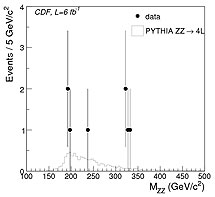 |
|
Nearly twice as many events as expected occured when the Z boson decayed into four leptons.
|
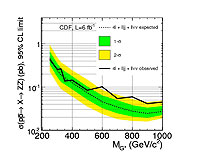 |
| Limits on the production rate of a new heavy particle decaying to a pair of Z bosons, as a function of mass.
|
The search for physics beyond the Standard Model has been frustrating. Even the opening of the new energy frontier at the LHC has not yet revealed obvious new phenomena, demonstrating the robustness of the current Standard Model. Yet, we know this model is incomplete and so the searches go on. Now, we’re taking a closer look at the data we already have in hand to try to find a chink in the armor.
Not knowing where that chink might lie, we make assumptions and probe. For instance, we might expect new heavy particles to decay preferentially to the heaviest known particles around. For example, in some models, gravitons can decay preferentially to Z boson pairs and so may have been missed by previous searches at the Tevatron and LHC. Events with Z pairs have distinctive signatures, so CDF physicists performed a search for events compatible with the decay of some new heavy particle.
A Z boson can decay into a pair of charged leptons, or into a pair of neutrinos, or into a pair of jets. We concentrated on three distinct final states of the Z boson pair. In each case, one of the Z bosons decays into a pair of electrons or muons. In the first case, the other Z also decays into a pair of charged leptons, also known as the four-lepton mode. In the second case, the other Z decays into a pair of neutrinos, and in the third case, it decays into a pair of jets.
In the four-lepton channel, we observed eight events, when 4.9 were expected. Unexpectedly, the Z pairs in four of the events had invariant mass around 325 GeV (see the top graph). It was surprising to see such large masses, and that the masses of each Z pair were so similar. Could this be a long awaited signature of a new particle?
What makes physics powerful is that the complete picture must be consistent. If the events observed in the four-lepton final state were from a new physics source, we would expect to see the same phenomenon in the other, higher-statistics, final states. When we looked at the second and third Z pair final states, we found 27 and 645 events when the expected yields are 26 ± 2.4 and 690 ± 47 respectively. Furthermore, the mass distributions showed no peaks corresponding to a mass of 325 GeV/c2.
Sadly, we concluded that the four-lepton events did in fact originate from Standard Model sources and we set limits on the production of new heavy particles using all three channels together (see the bottom graph). The pursuit of a sign of physics beyond the Standard Model goes on.
—Edited by Pavel Murat
 |
|
Aidan Robson, University of Glasgow; Victoria Giakoumopoulou, University of Athens; and Pavel Murat, Fermilab, carried out the analysis.
|
|
|